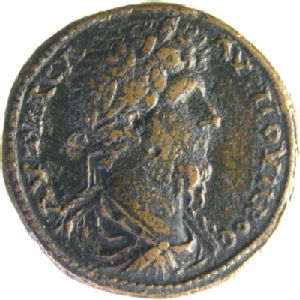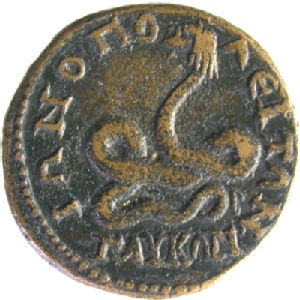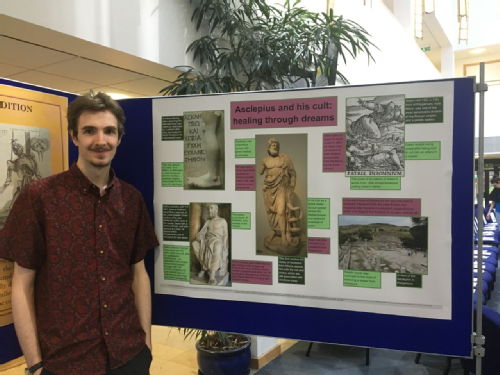All entries for Monday 01 April 2019
April 01, 2019
The snake–god and the satirist
 |
 |
This bronze coin from Abonuteichos, on the southern coast of the Black Sea, depicts the snake-god Glycon on the reverse. The serpent is depicted curled up, but with its head raised, and with long hair. It is labelled as ‘ΓΛΥΚΩΝ ΙΩΝΟΠΟΛΕΙΤΩΝ’ (Glycon of the Ionopolitans).
It was minted during the dual reign of Marcus Aurelius and Lucius Verus (AD 161-69). The latter is depicted on the obverse wearing a laurel, along with the legend ‘AVT KAC (sic) Λ ΑΥΡΗ οΥΗΡοC’ (Imperator Caesar L. Aurelius Verus).
This coin is especially interesting as a result of a treatise penned by the second century AD satirist Lucian. Alexander the False Prophet details how the titular Alexander (born c. AD 105-115) managed to con locals and outsiders alike into handing over their money in return for prophecies from Glycon, whose cult he founded. The survival of Lucian’s treatise gives us a fantastic opportunity to tie together material and literary evidence on the cult.
The first thing to notice on this coin is the long, thick hair of the snake, which is somewhat anthropomorphic. Lucian explains that even though the snake was living, a new head was crafted out of linen by Alexander and a colleague before the cult began:
they had long ago prepared and fitted up a serpent’s head of linen, which had something of a human look, was all painted up, and appeared very lifelike. It would open and close its mouth by means of horsehairs, and a forked black tongue like a snake’s, also controlled by horsehairs, would dart out.
Lucian, Alexander 12
Lucian explains how once this stage was complete, Alexander buried tablets prophesying that Asclepius would take up residence in Abonuteichos, which provoked people to build a temple (Lucian, Alexander 10). He then ran around in a frenzy, before ‘discovering’ a goose-egg, from which a baby snake emerged (Lucian, Alexander 13-14).
When the cult opened soon after, people apparently assumed that Glycon, the full-size snake-god shown on this coin, had grown out of this tiny snake within a few days (Lucian, Alexander 16). Lucian claims that when Glycon was being displayed at this grand opening, Alexander concealed its real head under his arm, showing only the linen head to the people (Lucian, Alexander 15). This is in contrast to the depiction on the coin, in which the anthropomorphic head is shown as a part of the snake’s body.
The cult then began offering predictions and oracles for anyone able to pay, and there were plenty of visitors, whom Lucian characterises as ‘thick-witted’ (Lucian, Alexander 17). Alexander would ask them to hand in their requests on scrolls, which he would unroll and secretly reseal, and pretend that the answer he gave them came from Glycon (Lucian, Alexander 19-20). He even purported to make Glycon’s (linen) head speak, thanks to an attendant using a horsehair mechanism and a tube (Lucian, Alexander 26).
Lucian’s account also broadly ties up with other evidence suggested by this coin. For example, the satirist writes that once Alexander gained fame, even in Rome, due to the rapid spread of the cult, he requested that a coin be produced with an image of himself on one side, and Glycon on the other (Lucian, Alexander 58). While we have never found any coins which depict Alexander himself (Jones (1986) 146), this coin shows that half of his desire was granted, at any rate.
According to Lucian, Alexander also requested that the Emperor change the name of his city from Abonuteichos to Ionopolis (Lucian, Alexander 58). Petsalis-Diomidis argues that this was a more prestigious name, relating to the mythical ancestor of the Ionians, Ion. This emphasis on Greek identity was perhaps enhanced by the success of the cult (Petsalis-Diomidis (2010) 31). Our coin does indeed display the name of Ionopolis. However, we need not assume that the rise of the cult and the name change came in parallel. This is because an earlier Glycon coin, minted under Antoninus Pius, uses the name Abonuteichos instead of Ionopolis, so the change must have been a gradual one (RPC IV 5359).
Some Epicureans, and even Lucian himself, attempted to expose the cult’s fraudulence. Alexander attempted to whip up the crowd to stone one such detractor (Lucian, Alexander 44-45), and Lucian himself claims to have been almost killed (Lucian, Alexander 56). Despite these efforts, however, the cult seemed to stay strong long after Lucian, because Glycon remained a popular image on Abonuteichos’s coinage from as late as the reign of Trebonianus Gallus in the mid-third century (RPC IX 1218).
Jones rightly suggests that we should take Lucian’s account with a pinch of salt. He argues that it is heavily biased, and contains many common tropes of invective literature, and that the question of fraudulence seems unanswerable or perhaps beside the point (Jones (1986) 134, 136, 146, 148). Nonetheless, literary and material evidence do provide a broadly unified picture for the fame, the influence and the imagery of the cult of Glycon.
 |
This month's entry was writte by Matthew Smith. Matthew is an MA by Research student at the University of Warwick. He is especially interested in Greek authors of the second century AD. His research focuses on the role which divine dreams from Asclepius played in medicine during this period, looking in particular at Galen and Aelius Aristides
Sources:
Petsalis-Diomidis, A. (2010) Truly Beyond Wonders: Aelius Aristides and the cult of Asklepios (Oxford University Press: Oxford)
Jones, C.P. (1986) Culture and Society in Lucian (Harvard University Press: Cambridge, M.A.)
Lucian, ‘Alexander the False Prophet’, in Lucian Volume IV, trans. A.M. Harmon (Harvard University Press: Cambridge, M.A. 1925)
 Clare Rowan
Clare Rowan

 Please wait - comments are loading
Please wait - comments are loading

 Loading…
Loading…